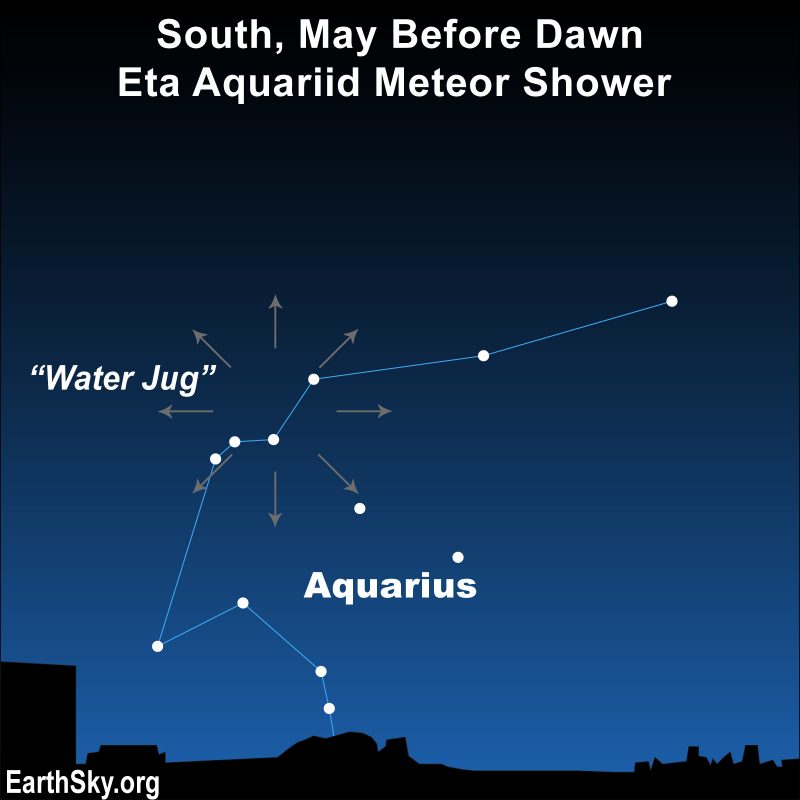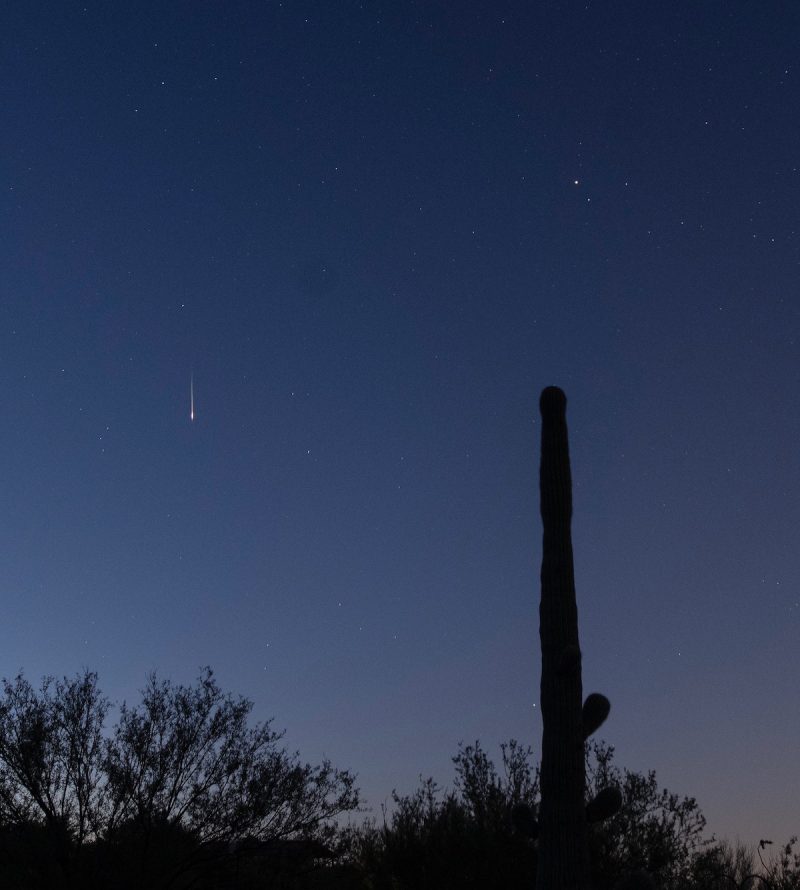May 2024 meteors … the Eta Aquariids
When to watch: New moon will fall a few days after the peak of the 2024 Eta Aquariid shower. So, mornings around the peak will be dark and moonless. The best mornings to watch are May 5 and 6, 2024, in the hours before dawn. Why before dawn? See “Radiant” below. The American Meteor Society is listing 8:43 UTC on May 5 as the shower’s predicted** peak time. But times vary between different experts. And the peak of this shower stretches out over several days. So you can expect elevated numbers of meteors a few days before and after the peak time.
Nearest moon phase: New moon will fall at 03:22 UTC on May 8. So a thin waning crescent moon will not obscure the 2024 Eta Aquariids on the mornings around the predicted peak.
Radiant: Will rise in the wee hours, climbing toward its highest point at dawn. That’s why before dawn will be the best time to watch this shower.
Duration of shower: April 15 to May 27.
Expected meteors at peak, under ideal conditions: In the southern half of the U.S., you might see 10 to 20 meteors per hour under a dark sky, with no moon, when the radiant is high in the sky. Farther south – at latitudes in the Southern Hemisphere – you might see two to three times that number.
Note: The Eta Aquariids’ radiant will be on the ecliptic, which will ride low in the sky on spring mornings as seen from the Northern Hemisphere. That’s why this shower favors the Southern Hemisphere. It’s often that hemisphere’s best meteor shower of the year.
Visit EarthSky’s meteor shower guide for 2024
Report a fireball (very bright meteor) to the American Meteor Society: it’s fun and easy!
The Eta Aquariids’ parent comet
This section is by the late, great Don Machholz (1952-2022), who discovered 12 comets …
The object responsible for the Eta Aquariid meteor shower – that is, its parent comet – is the famous Halley’s Comet. This comet is in a retrograde orbit around the sun. That means it runs around the sun in the opposite direction from Earth and all the other planets. As a result, we pass near its path twice, one time along the outbound portion of the comet’s orbit. That happens every early May, causing the Eta Aquariid meteor shower. The other time is along the inbound portion of the comet’s orbit, and that passage causes the Orionid meteor shower in late October of each year.
Halley’s Comet orbits the sun on an average of every 76 years (the range is from 74 through 79 years due to perturbations of the planets). So, in most years, the comet is nowhere near when we sweep through its orbit, and when debris left behind by the comet enters our atmosphere to create Halley’s two meteor showers.
Perhaps you saw Halley’s Comet when it returned last, in 1985/86. It has been observed since the year 240 BCE.Presently the comet is traveling heading back toward the sun at about 0.6 miles a second (0.9 km/sec).
In December of 2023, the comet reached its farthest point from the sun that binds it in orbit. Then – pulled inexorably by the sun’s gravity – it curved around and is heading back toward the inner solar system again. Halley’s Comet will be back in 2061.
While waiting for Halley’s Comet to return, watch for the next best thing: the Eta Aquariid meteor shower in early May.
More about this shower’s radiant
If you trace the paths of the Eta Aquariid meteors backward, they all seem to radiate from a certain point in front of the constellation Aquarius the Water Bearer. This point on the sky’s dome is called the radiant of the meteor shower, which nearly aligns with the faint star Eta Aquarii. Hence, this meteor shower gets its name from this star.
Eta Aquarii is one of the four stars making up the Y-shaped Water Jar asterism in the northern part of Aquarius. If you can find the Water Jar in the constellation Aquarius, you’ve as good as located the radiant point for the Eta Aquariid meteors. The alignment of the radiant and the star is, of course, coincidental. Eta Aquarii is some 170 light-years away – trillions upon trillions of miles away – while the Eta Aquariid meteors burn up nearby – only 60 miles (100 km) above Earth’s surface.
Meteor shower radiants are sometimes misunderstood by casual meteor-watchers. You don’t need to know where they are to watch a meteor shower. That’s because the meteors fly every which way across the sky, in front of numerous constellations. However, the higher a shower’s radiant appears in your sky, the more meteors you’re likely to see. For the Eta Aquariids, the radiant soars highest in the nighttime sky just before dawn. That’s one of the reasons why you can expect to see the most meteors in the wee morning hours.
How to view a meteor shower
As with all meteors in annual showers, no special equipment to watch the Eta Aquariids. But a little luck always helps.
Find a dark, open sky away from artificial lights, and sprawl out on a reclining lawn chair.
Make yourself comfortable with a hot flask of you favorite beverage. Keep warm but not so snug that you fall asleep!
Meteor watching is a lot like fishing. Sometimes you catch a good number of them, and sometimes you don’t.
Meteor showers: Tips for watching the show
Eta Aquariid meteor shower photos from EarthSky’s community
Bottom line: May’s Eta Aquariid meteor shower has a broad peak and often can be watched over several mornings. In 2024, the mornings of May 5 and 6 will be the best time to watch and the moon won’t interfere.
**Predicted peak times and dates for meteor showers are from the American Meteor Society. Note that meteor shower peak times can vary. Back to top.
Read more: Why the Eta Aquariids are best from the Southern Hemisphere.















